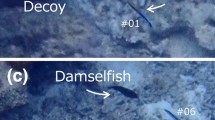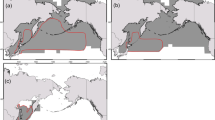Abstract
A prerequisite for a parasitic manipulation to be considered adaptive is that it confers a fitness benefit to the parasite, such as increased transmission to another host. These manipulations can involve alterations to a wide range of host phenotypic traits, including microhabitat choice. Eye flukes of the trematode family Diplostomidae use fish as intermediate hosts and must be transmitted by predation to a piscivorous bird. In New Zealand, the diplostomid Tylodelphys darbyi infects the eyes of a widespread endemic freshwater fish, the common bully Gobiomorphus cotidianus. Within the eye, T. darbyi metacercariae achieve large sizes and move freely about the aqueous and vitreous humors of the eye. We hypothesized that higher intensities of T. darbyi would (i) cause bullies to show increased activity and spend more time moving about in open space (i.e., more conspicuous, risky microhabitat) and (ii) reduce their ability to compete for shelter with fish harboring lower infection levels. Our experiments showed that heavily infected fish were more active and spent more time in the open, although the effect was age-dependent, with immature fish displaying decreases in activity and time spent in the open with increasing intensities of infection. We also demonstrated that heavily infected female bullies have a lower probability of using shelter, but males show the opposite pattern. It is possible that using more risky microhabitats increases the likelihood of the fish being eaten by the parasite’s predatory avian definitive hosts. However, our findings indicate that age- and sex-dependent effects call for a more nuanced interpretation.





Similar content being viewed by others
References
Andersen SB, Gerritsma S, Yusah KM, Mayntz D, Hywel-Jones NL, Billen J, Boomsma JJ, Hughes DP (2009) The life of a dead ant: the expression of an adaptive extended phenotype. Am Nat 174:424–433. https://doi.org/10.1086/603640
Barber I, Crompton DWT (1997a) The ecology of Diplostomum phoxini infections in two minnow (Phoxinus phoxinus) populations in Scotland. J Helminthol 71:189–196. https://doi.org/10.1017/S0022149X0001590X
Barber I, Crompton DWT (1997b) The distribution of the metacercariae of Diplostomum phoxini in the brain of minnows, Phoxinus phoxinus. Folia Parasitol 44:19–25
Barber I, Poulin R (2002) Interactions between fish, parasites, and disease. In: Hart PJB, Reynolds JD (eds) Handbook of fish biology and fisheries. Blackwell Publishing, Oxford, pp 359–389
Barber I, Wright HA (2006) Effects of parasites on fish behaviour: interactions with host physiology. Fish Physiol 24:109–149. https://doi.org/10.1016/S1546-5098(05)24004-9
Barber I, Huntingford FA, Crompton DWT (1995) The effect of hunger and cestode parasitism on the shoaling decisions of small freshwater fish. J Fish Biol 47:524–536
Barber I, Hoare D, Krause J (2000) Effects of parasites on fish behaviour: a review and evolutionary perspective. Rev Fish Biol Fish 10:131–165
Bethel WM, Holmes JC (1973) Altered evasive behaviour and response to light in amphipods harbouring acanthocephalan cystacanths. J Parasitol 59:945–956
Blasco-Costa I, Poulin R, Presswell B (2017) Morphological description and molecular analyses of Tylodelphys sp. (Trematoda: Diplostomidae) newly recorded from the freshwater fish Gobiomorphus cotidianus (common bully) in New Zealand. J Helminthol 91:332–345. https://doi.org/10.1017/S0022149X16000298
Brassard P, Rau ME, Curtis MA (1982) Parasite-induced susceptibility to predation in diplostomiasis. Parasitol 85:495–501
Bolek MG, Rogers E, Szmygiel C, Shannon RP, Doerfert-Schrade WE, Schmidt-Rhaesa A, Hanelt B (2013) Survival of larval and cyst stage of gordiids (Nematomorpha) after exposure to freezing. J Parasitol 99:397–402
Breheny P, Burchett W (2017) Visualization of regression models using visreg. R J 9:56–71
Duneau D, Ebert D (2012) Host sexual dimorphism and parasite adaptation. PLoS Biol 10:1–9
Fredensborg BL, Longoria AN (2012) Increased surfacing behaviour in longnose killifish infected by brain-encysting trematode. J Parasitol 98:899–903. https://doi.org/10.1645/GE-3170.1
Holmes JC, Bethel WM (1972) Modification of intermediate host behaviour by parasites. Zool J Linnean Soc 51:123–149
Kalbe M, Kurtz J (2006) Local differences in immunocompetence reflect resistance of sticklebacks against the eye fluke Diplostomum pseudospathaceum. Parasitol 132:105–116
Karvonen A, Seppälä O, Valtonen T (2004) Eye fluke-induced cataract formation in fish: quantitative analysis using an ophthalmological microscope. Parasitol 129:473–478. https://doi.org/10.1017/S0031182004006006
Koolhaas JM (2008) Coping style and immunity in animals: making sense of individual variation. Brain Behav Immun 22:662–667
Koprivnikar J, Gibson CH, Redfern JC (2011) Infectious personalities: behavioural syndromes and disease risk in larval amphibians. Proc R Soc B 279:1544–1550
Lafferty K, Morris AK (1996) Altered behaviour of parasitized killifish increases susceptibility to predation by bird final hosts. Ecology 77:1390–1397. https://doi.org/10.2307/2265536
Lafferty K (1999) The evolution of trophic transmission. Parasitol Today 15:111–115. https://doi.org/10.1016/S0169-4758(99)01397-6
Lester RJG (1971) The influence of Schistocephalus pleroceroids on the respiration of Gasterosteus and a possible resulting effect on the behavior of the fish. Can J Zool 49:361–366
Locke SA, McLaughlin D, Marcogliese DJ (2010) DNA barcodes show cryptic diversity and a potential physiological basis for host specificity among Diplostomoidea (Playthelminthes: Digenea) parasitizing freshwater fishes in the St. Lawrence River, Canada. Mol Ecol 19:2813–2827
McDowall RM (1990) New Zealand freshwater fishes: a natural history and guide. Heinemann Reed MAF Publishing Group, Auckland
Moore J (1983) Responses of an avian predator and its isopod prey to an acanthocephalan parasite. Ecology 64:1000–1015
Moore J (1984) Altered behavioural response in intermediate hosts – an acanthocephalan parasite strategy. Am Nat 123:572–577
Moore J, Lasswell J (1986) Altered behaviour in isopods (Armadillidium vulgare) infected with the nematode Dispharynx nasuta. J Parasitol 72:186–189
Moore J (2002) Parasites and the behavior of animals. Oxford University Press, Oxford
Moore J (2013) An overview of parasite-induced behavioural alterations – and some lessons from bats. J Exp Biol 216:11–17. https://doi.org/10.1242/jeb.074088
Muñoz JCV, Staaks G, Knopf K (2017) The eye fluke Tylodelphys clavata affects prey detection and intraspecific competition of European perch (Perca fluviatilis). Parasitol Res 116:2561–2567. https://doi.org/10.1007/s00436-017-5564-1
Muñoz JCV, Bierbach D, Knopf K (2019) Eye fluke (Tylodelphys clavata) infection impairs visual ability and hampers foraging success in European perch. Parasitol Res 118:2531–2541. https://doi.org/10.1007/s00436-019-06389-5
Owen SF, Barber I, Hart PJB (1993) Low level infection by eye fluke, Diplostomum spp., affects the vision of three-spined sticklebacks, Gasterosteus aculeatus. J Fish Biol 42:803–806
Poinar G, Yanoviak SP (2008) Myrmeconema neotropicum n. g., n. sp., a new tetradonematid nematode parasitising South American populations of Cephalotes atratus (Hymenoptera: Formicidae), with the discovery of an apparent parasite-induced host morph. Syst Parasitol 69:145–153
Poulin R, Rau ME, Curtis MA (1991) Infection of brook trout fry, Salvelinus fontinalis, by ectoparasitic copepods: the role of host behaviour and initial parasite load. Anim Behav 41:467–476
Poulin R (2010) Parasite manipulation of host behaviour: an update on frequently asked questions. In: Brockmann HJ (ed) Advances in the study of behavior. Elsevier Inc. Academic Press, New York, pp 151–186
Poulin R (2018) Modification of host social networks by manipulative parasites. Behaviour 155:671–688
Presswell B, Blasco-Costa I (2019) Description of Tylodelphys darbyi n. sp. (Trematoda: Diplostomidae) from the threatened Australasian crested grebe (Podiceps cristatus australis, Gould 1844) and linking of its life-cycle stages. J Helminthol:1–8. https://doi.org/10.1017/S0022149X19000142
Rahel FJ, Stein RA (1988) Complex predator-prey interactions and predator intimidation among crayfish, piscivorous fish, and small benthic fish. Oecologia 75:94–98
Richards EL, van Oosterhout CJ (2010) Sex-specific differences in shoaling affect parasite transmission in guppies. PLoS One 5:1–6
Ruehle B, Poulin R (2019) No impact of a presumed manipulative parasite on the responses and susceptibility of fish to simulated predation. Ethology:1–10. https://doi.org/10.1111/eth.12927
Seppälä O, Karvonen A, Valtonen T (2004) Parasite-induced change in host behaviour and susceptibility to predation in an eye fluke-fish interaction. Anim Behav 68:257–263. https://doi.org/10.1016/j.anbehav.2003.10.021
Seppälä O, Karvonen A, Valtonen T (2005a) Manipulation of fish host by eye flukes in relation to cataract formation and parasite infectivity. Anim Behav 70:889–894. https://doi.org/10.1016/j.anbehav.2005.01.020
Seppälä O, Karvonen A, Valtonen ET (2005b) Impaired crypsis of fish infected with a trophically transmitted parasite. Anim Behav 70:895–900
Seppälä O, Karvonen A, Valtonen T (2008) Shoaling behaviour of fish under parasitism and predation risk. Anim Behav 75:145–150. https://doi.org/10.1016/j.anbehav.2007.04.022
Stephens RTT (1982) Reproduction, growth and mortality of the common bully, Gobiomorphus cotidianus McDowall, in a eutrophic New Zealand lake. J Fish Biol 20:259–270
Stephenson JF, van Oosterhout C, Mohammed RS, Cable J (2015) Parasites of Trinidadian guppies: evidence for sex- and age-specific trait-mediated indirect effects of predators. Ecology 96:489–498
Stumbo AD, Poulin R (2016) Possible mechanism of host manipulation resulting from a diel behaviour pattern of eye-dwelling parasites? Parasitol 143:1261–1267. https://doi.org/10.1017/S0031182016000810
Tadiri CP, Scott ME, Fussman GF (2016) Impact of host sex and group composition on parasite dynamics in experimental populations. Parasitology 143:523–531
Ubels JL, DeLong RJ, Hoolsema B, Wurzberger A, Nguyen TT, Blankespoor HD, Blankespoor CL (2018) Int J Parasitol Parasites Wildl 7:171–179
Voutilainen A, Figueiredo K, Huuskonen H (2008) Effects of the eye fluke Diplostomum spathaceum on the energetics and feeding of Arctic charr Salvelinus alpinus. J Fish Biol 73:2228–2237
Voutilainen A, Huuskonen H, Taskinen J (2010) Penetration and migration success of Diplostomum spp. cercariae in Arctic charr. J Parasitol 96:232–235
Wesolowska W, Wesolowski T (2014) Do Leucochloridium sporocysts manipulate the behavior of their snail hosts? J Zool 292:151–155. https://doi.org/10.1111/jzo.12094
Wilson DS, Coleman K, Clark AB, Biederman L (1993) Shy-bold continuum in pumpkinseed sunfish (Lepomis gibbosus): an ecological study of a psychological trait. J Comp Physiol 107:250–260
Acknowledgments
We want to thank Jolyn Chia and the Evolutionary and Ecological Parasitology Lab at the University of Otago for the technical and field assistance.
Funding
Brandon Ruehle received funding from the University of Otago Brandon Ruehle via a postgraduate scholarship and associated student budget.
Author information
Authors and Affiliations
Corresponding author
Ethics declarations
Ethical approval
All applicable international, national, and/or institutional guidelines for the care and use of animals were followed. All procedures performed in studies involving animals were in accordance with the ethical standards of the University of Otago Animal Ethics Committee (# 70/17001).
Conflict of interest
The authors declare that they have no conflict of interest.
Additional information
Section Editor: Guillermo Salgado-Maldonado
Publisher’s note
Springer Nature remains neutral with regard to jurisdictional claims in published maps and institutional affiliations.
Rights and permissions
About this article
Cite this article
Ruehle, B., Poulin, R. Risky business: influence of eye flukes on use of risky microhabitats and conspicuousness of a fish host. Parasitol Res 119, 423–430 (2020). https://doi.org/10.1007/s00436-019-06589-z
Received:
Accepted:
Published:
Issue Date:
DOI: https://doi.org/10.1007/s00436-019-06589-z




